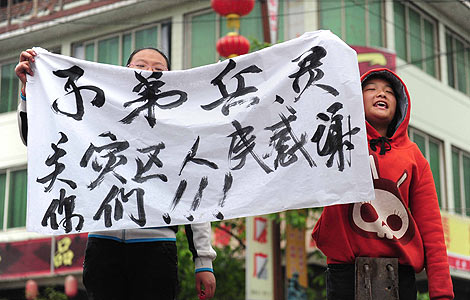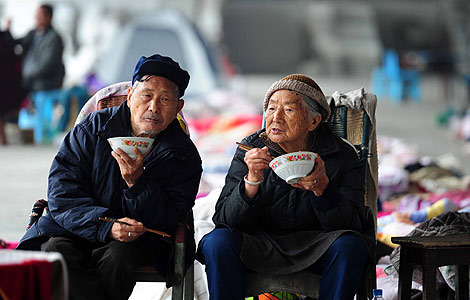Industry faces recovery fight
Updated: 2013-04-24 01:29
By WEI TIAN (China Daily)
|
||||||||
The country's industry is still in a protracted struggle for recovery and for a shift to better serve domestic consumers, according to information provided by the Ministry of Industry and Information Technology on Tuesday.
In the first quarter, industry saw 9.5 percent value-added growth year-on-year, slower than the 10 percent seen in the previous quarter, and even slower than the 11.6 percent in the first quarter of 2012.
Economists warned that the sector's slower growth may force the country to rely more on growth driven by capital investment, resulting in an even greater challenge to its plan to rely increasingly on domestic consumption.
Heavy industry registered 9.8 percent value-added growth year-on-year, while light industry saw 8.7 percent, and the technology industry saw 11.9 percent growth.
Xiao Chunquan, a ministry spokesman, said at a news conference in Beijing that a moderate decline should be seen as a normal phenomenon after industry's rapid growth in the past two decades.
"A slowdown of growth in industrial activities will help ease the pressure on the environment and resources. It also makes room for the structural adjustment of the economy," Xiao said.
He added that the industrial sector faces considerable pressure from a lack of robust growth in consumption as well as in the investment in fixed assets.
Domestic consumption growth fell 2.4 percentage points in the first quarter from the previous year, while investment growth was on par with that of the first quarter of last year, according to the National Bureau of Statistics.
In the first two months, large industrial companies saw their combined profits rise 17.2 percent year-on-year, while profits from their main business lines rose only 5.2 percent. Meanwhile, some 20 percent of the companies were still running at a loss.
The GDP of the world's second-largest economy expanded 7.7 percent in the first quarter, and most analysts said the figure could rise to about 8 percent in the second quarter.
Song Guoqing, a professor of economics at Peking University, who is also an adviser to the central bank, said at a recent conference that GDP growth in the second quarter might hover at around 8.1 percent.
Zhu Baoliang, an economist with the State Information Center, pointed out that the unemployment rate did not rise to the point that the government had to revise its policy focus — although growth will continue to be "very much driven by government-backed investment projects" in the second quarter.
The expected shift in the growth model — meaning growth relying more on domestic consumption than government investment or exports — is still a long way from now, he said.
At a recent executive meeting of the State Council, Premier Li Keqiang called for more efforts to boost domestic consumption.
Xiao, the ministry spokesman, said, "Consumption is playing an increasingly important role in supporting growth."
He highlighted the role played by the IT sector in boosting consumption growth. China's e-commerce sector grew 45 percent year-on-year to 2.4 trillion yuan (384.46 billion) in the first quarter.
Wang Tao, chief economist with UBS, wrote in a research note that the dampening impact of the anti-corruption campaign on consumption is decreasing, therefore consumption will pick up in the second quarter.
But she also noted the rapid credit expansion in the first quarter, accompanied by the urbanization drive, which will generate more growth in fixed-asset investments, especially in infrastructure.
In the first quarter, Chinese banks provided 2.76 trillion yuan in new loans, 300 billion yuan more than in the same period last year.
"China should work out a more detailed urbanization plan," said Liu Ligang, chief economist in China with ANZ Banking Group. "Otherwise the process will be inefficient and will encourage more investment-driven growth."

 Rescuers win people’s hearts
Rescuers win people’s hearts
 House damaged, life continues in Sichuan
House damaged, life continues in Sichuan
 Relief reaches isolated village
Relief reaches isolated village
 Rainfall poses new threats to quake-hit region
Rainfall poses new threats to quake-hit region
 Funerals begin for Boston bombing victims
Funerals begin for Boston bombing victims
 Quake takeaway from China's Air Force
Quake takeaway from China's Air Force
 Obama celebrates young inventors at science fair
Obama celebrates young inventors at science fair
 Earth Day marked around the world
Earth Day marked around the world
Most Viewed
Editor's Picks

|

|

|

|

|

|
Today's Top News
China's 2nd aircraft carrier will be 'larger'
China thanks countries
for quake relief aid
China, US to enhance mutual trust
Beijing protests Diaoyu incident
Copyrights take a bite out of Apple
Four new H7N9 cases
Landslide kills 9 in SW China
China, Europe need one another
US Weekly

|

|






